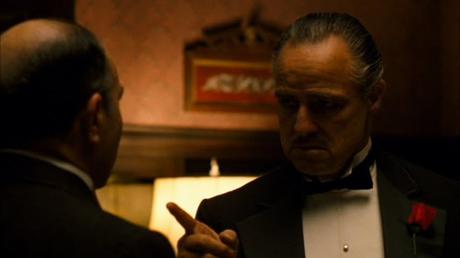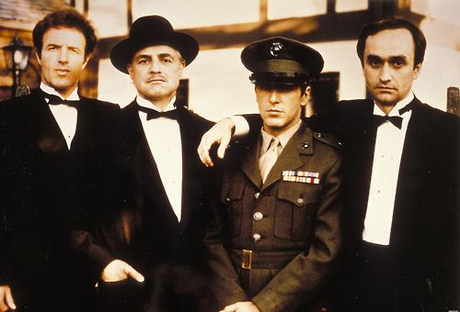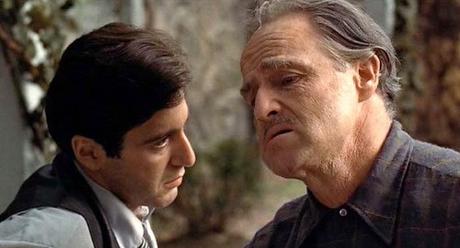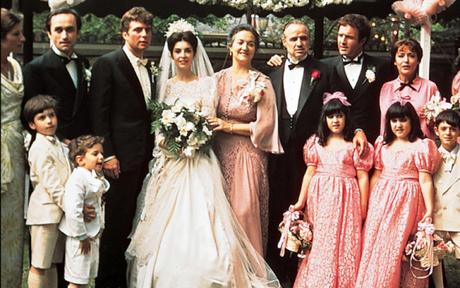 Don Corleone (Marlon Brando) speaks to Bonasera (Salvatore Corsitto) in The Godfather, Part I
Don Corleone (Marlon Brando) speaks to Bonasera (Salvatore Corsitto) in The Godfather, Part I“I believe in America,” an unseen voice exclaims. After which, a dull, amber-colored light illuminates the person speaking: a man with a comb-over in his mid-50s, dressed in a black tuxedo and winged collar. The camera now begins to pull back — slowly and deliberately — matching the cadences of the man’s speech. The speaker resumes his story. “America has made my fortune. And I raised my daughter in the American fashion.”
While he is speaking, the camera continues to spend an inordinate amount of time studying the man’s features: his dark eyes, his mouth, his foreign accent, his distressed tone, and his obvious discomfort at having to beg for a favor from the dreaded godfather, Don Vito Corleone. The man telling his tale of woe is the sorrowful undertaker Bonasera (Salvatore Corsitto), who informs Don Corleone of how his beloved daughter was attacked and nearly raped by two young men, one of whom was her boyfriend. “She resisted. She kept her honor,” he exclaims, his eyes glowing with pride, but, as Bonasera then reveals, “they beat her like an animal.” He starts to weep.
Seconds later, with the camera pulling back, the blurred, shadowy form of a figure is seen at left. The figure signals with his right hand for one of the listeners in the room to provide the undertaker with some refreshment. Continuing to pull back, the camera now shows Bonasera is his chair growing smaller and smaller before our eyes, while the figure at left starts to take shape behind a desk, looming larger and larger in comparison.
And so begins one of the most influential Hollywood movies of the seventies, with the cautiously chosen words of the sorrowful undertaker Amerigo Bonasera making a desperate plea for justice in Don Corleone’s inner sanctum. This scene, so memorable in its outcome and so carefully constructed and paced by the actors and crew, sets the stage for what is to come. It broadcasts the undisputed fact of the godfather’s hold on men, only to see that hold slip away and deteriorate with the unraveling his realm by others.
Francis Ford Coppola’s directing career took off like a rocket as a result of this film’s unprecedented popularity and success. It made him and Paramount Pictures a bigger fortune than either of them could ever have imagined. Mario Puzo’s pulp novel The Godfather – not exactly high art or intellectually challenging as great literature – came to passionate life in Coppola’s now-classic depiction of the Sicilian-American underworld (we know what he meant, even though the word “Mafia” is never uttered).

Postwar America is the setting for this violent tale of Don Corleone, the godfather of the title, who lords it over his crime syndicate as one of the heads of the five New York “families.” Gambling, prostitution, murder incorporated, judges in their hip pockets, and nefarious bribery schemes are the syndicate’s life blood. The men who work for this syndicate are bound to each other by their adherence to a code of honor. But incredibly, the godfather refuses to dabble in illegal drugs, which makes Don Corleone out to be a beggar among thieves. His unequivocal stand against dope dealing lands him and his family in hot water with the opposing forces longing to take over his territory. And honor to a code, as we learn in the end, can both be adhered to or not.
Played by the legendary method-actor Marlon Brando, the Don is power personified: a lift of a hand, a cock of the head, a mere whisper into someone’s ear, and his slightest whim is dutifully obeyed and carried out, especially by head enforcer Luca Brasi (former wrestler Lenny Montana). Both are giants among mortals, or so they are meant to appear. But it’s all an illusion, wiped away by the necessities of their chosen profession.
Brando won a well-deserved Best Actor Oscar (he refused it, however, sending in his place an actress posing as a Native American) for his subtle, tour de force performance as Don Corleone, even though he’s relegated to what is essentially a supporting role. For a film that concerns itself with such disreputable types as hoods and gangsters, Brando is still able to find the human element in many a situation. For instance, his playful handling of grandson Anthony in the garden scene late in the picture, where he places an orange peel into his mouth and musses his hair up like a scarecrow to frighten the little boy with a monstrous visage, only to comfort the crying child a split second later.
Equally deserving of mention is Al Pacino (note the fire in his eyes as he talks) as youngest son Michael. It’s been said that Francis Coppola’s film is about the dark side of the American dream, and there are many instances throughout where this dictum has been carried out with startling efficiency (e.g., the decapitated horse’s head, the bullet through Moe Green’s eye). While true enough in practice, the real crux of the drama (with a screenplay by Coppola and author Puzo) is the unquestioned loyalty and devotion Michael feels towards his father, despite Michael’s distaste for dad’s “work.” Michael proves his love by taking over the family business after Don Corleone is seriously injured in a botched assassination attempt — perpetrated by the shifty-eyed Virgil Sollozzo (a cagey Al Lettieri) — and after hot-headed brother Sonny (James Caan, equally hot-tempered) is gunned down at a Long Island toll booth.

So many quotable lines (“I’m gonna make him an offer he can’t refuse,” “Leave the gun, take the cannolis,” and “Never tell anyone outside the family what you’re thinking”), so many individualized portraits (i.e., Clemenza, Tessio, the Tattaglias, Apollonia, Don Tommasino, Fabrizio), it’s one of those pictures that demands repeated viewings as well as our undivided attention. No matter how many times you’ve seen The Godfather, there are always fresh insights to be savored, over and over again: the opening trumpet solo — mournful, longing, full of untold regret; right-hand man and ex-cop, Al Neri (Richard Bright), closing the door on Michael’s wife Kay (Diane Keaton); Brando’s tearful breakdown (“Look how they massacred my boy”) upon viewing the dead Sonny’s shattered features at Bonasera’s funeral parlor; that ironic, masterfully orchestrated finale whereby Michael all-but wipes the slate clean of his father’s foes while standing stoically as godfather to his sister Connie’s child; and many more.
With a fine ensemble cast, including Robert Duvall as the family consigliere Tom Hagen, Talia Shire (Coppola’s real-life sister) as Connie, John Cazale as Michael’s older brother Fredo, Richard Castellano as the fat Pete Clemenza, Abe Vigoda (Fish in Barney Miller) as Tessio, Alex Rocco as Moe Green, and John Marley, Sterling Hayden, Richard Conte, Al Martino, Morgana King, Gianni Russo, Vito Scotti, Simonetta Stefanelli, Angelo Infanti as Fabrizio, and Gabriele Torrei (uncredited) as Enzo the nervous baker. The striking cinematography is by the late Gordon Willis, with incredibly detailed production designs by Dean Tavoularis, and of course that instantly recognizable film theme by Nino Rota.

Speaking of film scores, there are two romantic ballads featured in the picture: one, the pop song “I Have But One Heart,” sung by Al Martino at Connie’s wedding, was originally published in 1945 and recorded by Vic Damone, with music written by Johnny Farrow and lyrics by Marty Symes; the other number, the so-labeled “Love Theme from The Godfather” — more familiarly known as “Speak Softly Love” — was composed by Nino Rota, with lyrics by Larry Kusik. Given an Academy Award nomination for Best Original Score of 1973, Rota was disqualified from competition when it was learned that “Speak Softly Love” was previously used by him for a 1958 movie called Fortunella.
Need we say more?
Copyright © 2015 by Josmar F. Lopes

